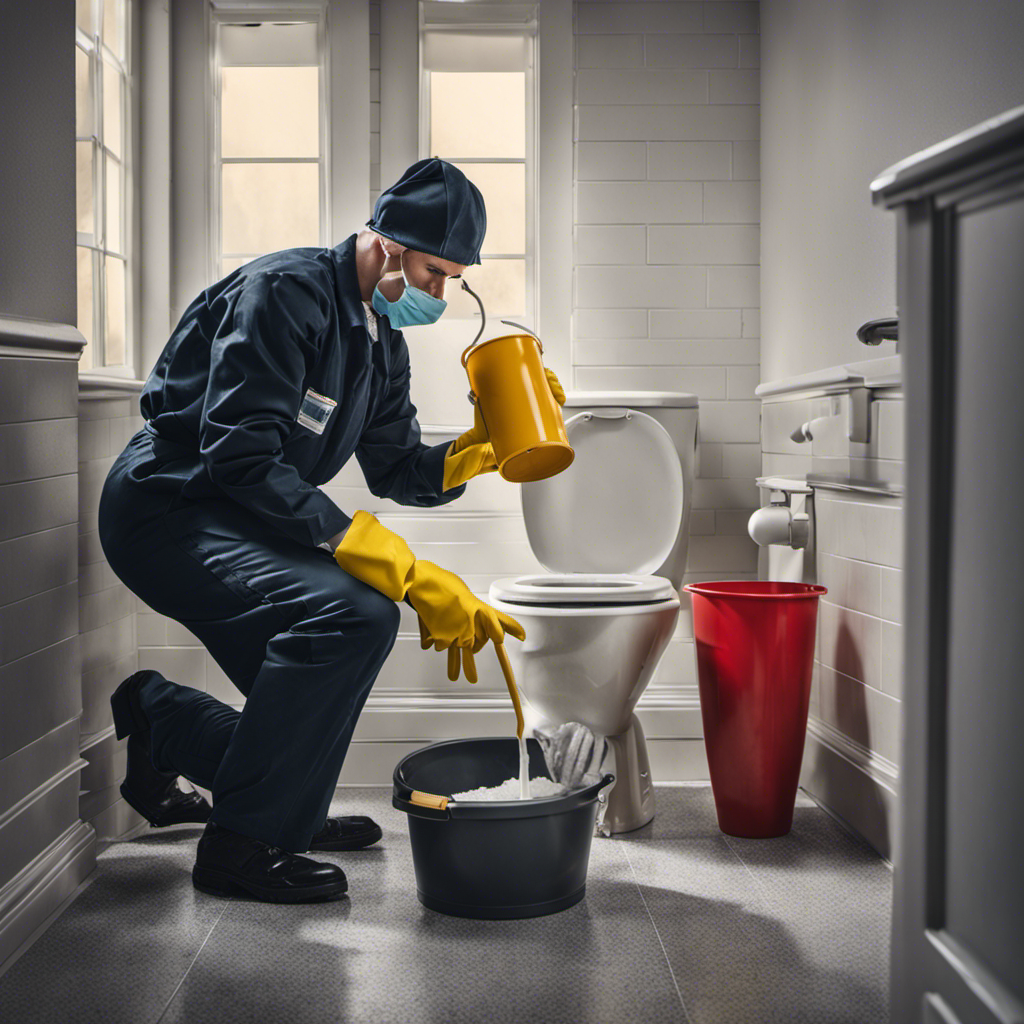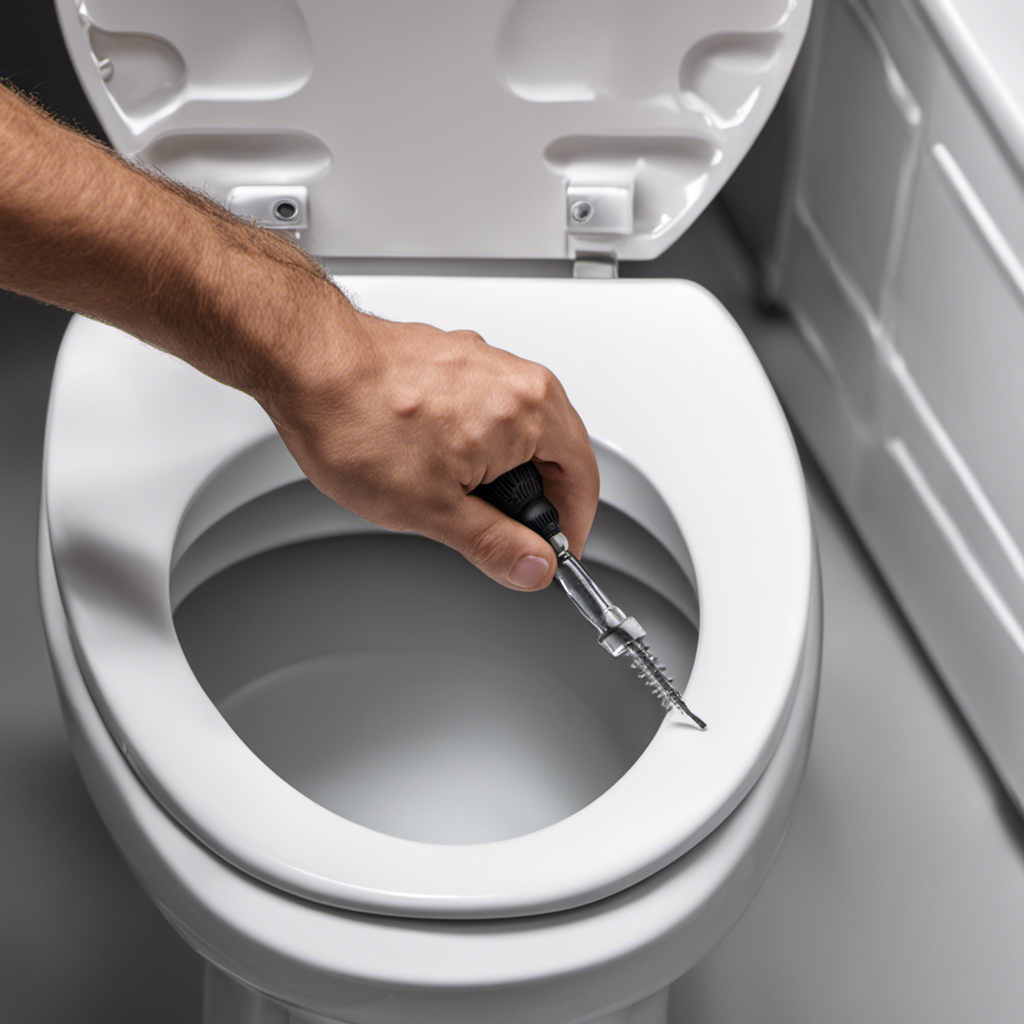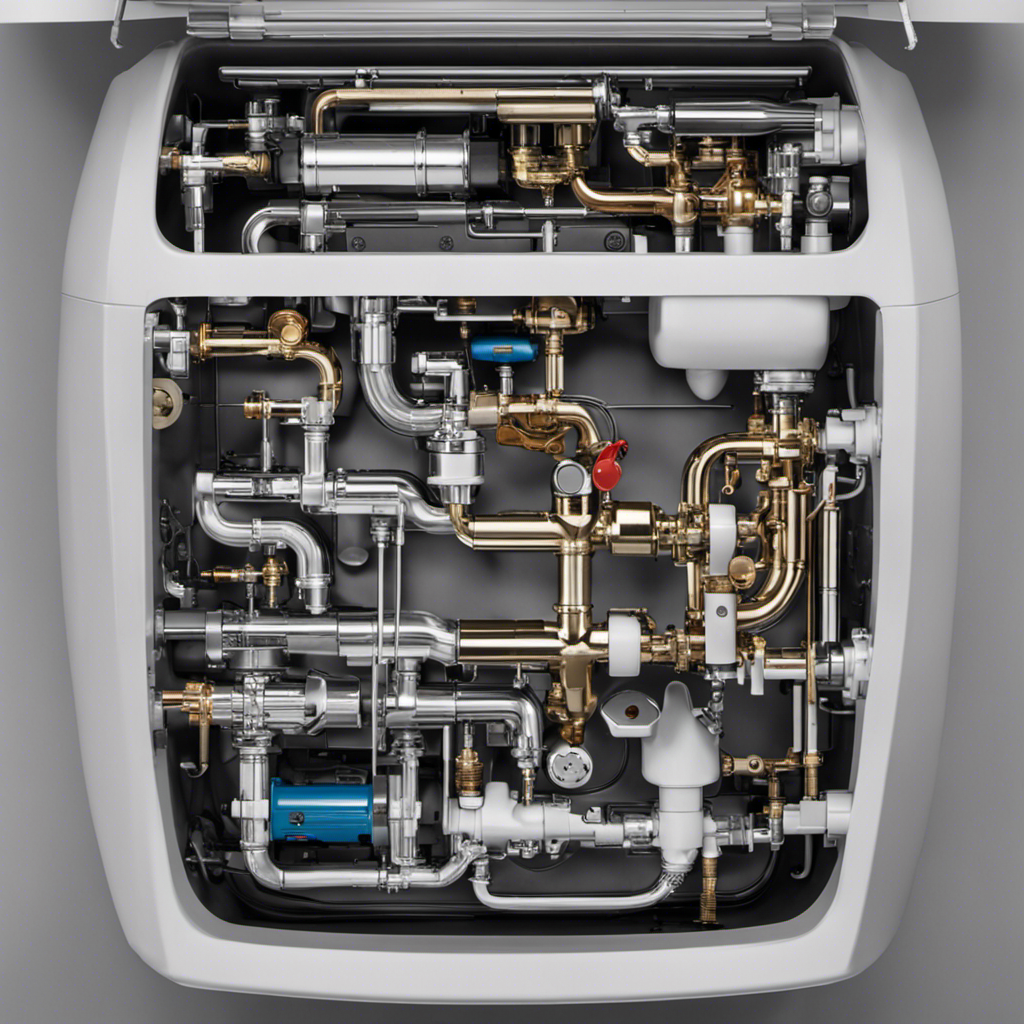I’ve faced my fair share of clogged toilets, and let me tell you, it’s not a pleasant experience.
But fear not, because I’ve discovered a simple yet effective technique that doesn’t require a plunger.
In this article, I’ll guide you through the step-by-step process of plunging a toilet without a plunger.
From alternative tools to natural remedies, I’ll provide you with all the information you need to tackle this pesky problem.
So, let’s dive in and learn how to unclog a toilet like a pro!
Key Takeaways
- Using a wire coat hanger or toilet snake can be effective alternatives to a traditional plunger for unclogging a toilet.
- A mixture of hot water and dish soap can also help break down clogs and facilitate plunging without a plunger.
- It is important to avoid pushing too hard when plunging without a plunger, as excessive force may cause water to splash out or not guarantee a solution.
- Seeking professional help may be necessary if the blockage is stubborn or severe and other methods fail.
The Importance of Proper Toilet Maintenance
If you don’t properly maintain your toilet, you may end up dealing with more frequent clogs and backups.
To avoid these issues, it’s important to follow some simple toilet maintenance tips.
First, be mindful of what you flush down the toilet. Common causes of toilet clogs include flushing items such as sanitary products, wipes, or excessive amounts of toilet paper. It’s important to only flush toilet paper and waste.
Additionally, regular cleaning is essential for proper maintenance. Use a toilet brush and cleaner to remove any buildup or residue.
Finally, check the water level in the tank periodically. If it’s too high or too low, it can affect the flushing performance.
Alternative Tools for Unclogging a Toilet
One option for unclogging a toilet without a plunger is using a wire coat hanger. This DIY unclogging method can be effective if executed correctly. To begin, straighten out the hanger and create a small hook at one end. Carefully insert the hooked end into the toilet bowl, making sure not to scratch the porcelain. Gently maneuver the hanger through the drain, trying to dislodge any blockages along the way.
Another tool that can be used in a similar manner is a toilet snake, which is a flexible cable with a handle on one end. It is designed specifically for unclogging toilets and can reach deeper into the drain.
Both the wire coat hanger and the toilet snake are cost-effective alternatives to a traditional plunger and can be utilized in emergency situations.
Step-by-Step Guide to Plunging a Toilet Without a Plunger
When it comes to unclogging a toilet, there are alternative plunging methods that can be just as effective as using a traditional plunger. In this discussion, I will explore these alternative methods and provide a step-by-step guide on how to use them.
Additionally, I will also provide tips on preventing future clogs to help maintain a functional and clog-free toilet.
Alternative Plunging Methods
There’s a simple and effective way to plunge a toilet without a plunger using a mixture of hot water and dish soap. This alternative method can be useful when you don’t have a plunger readily available or prefer not to use one. Here’s how you can do it:
- Pour a generous amount of dish soap into the toilet bowl.
- Boil a pot of water on the stove.
- Carefully pour the hot water into the toilet bowl from waist height.
- Wait for a few minutes to allow the hot water and dish soap to work their magic.
- Use a toilet bowl brush to gently agitate the water and soap mixture.
- Flush the toilet to see if the clog has been cleared.
Preventing Future Clogs
To prevent future clogs, it is important to regularly clean and maintain your toilet. Here are some essential toilet maintenance tips to help keep your toilet in good condition:
-
Regular Cleaning: Clean your toilet bowl and seat regularly to prevent the build-up of grime and bacteria.
-
Proper Flushing: Teach everyone in your household to flush only toilet paper and waste, avoiding flushing items like wipes or feminine hygiene products.
-
DIY Drain Cleaner: Avoid using chemical drain cleaners as they can damage your pipes. Instead, try a DIY drain cleaner made of baking soda and vinegar. Pour half a cup of baking soda followed by half a cup of vinegar into the toilet bowl. Let it sit for a few minutes, then flush with hot water.
-
Regular Inspections: Check your toilet tank and bowl for any signs of leaks or cracks. Repair or replace any faulty parts promptly.
By following these toilet maintenance tips, you can prevent future clogs and ensure a smoothly functioning toilet.
Now, let’s explore some natural remedies for clearing a clogged toilet.
Natural Remedies for Clearing a Clogged Toilet
When faced with a clogged toilet, there are several natural remedies that can help clear the blockage.
One effective method is using a combination of vinegar and baking soda. By pouring one cup of baking soda followed by one cup of vinegar into the toilet bowl, the mixture will create a fizzy reaction that can break down the clog.
Another option is the hot water method, where boiling water is poured into the toilet bowl to soften and dissolve the obstruction.
Lastly, if these methods don’t work, a toilet auger can be used as an alternative. By inserting the auger into the toilet drain and turning the handle, it can help dislodge and remove the blockage.
Vinegar and Baking Soda
Mix vinegar and baking soda together in a bowl to create a powerful solution for unclogging your toilet. This simple DIY hack can save you from the inconvenience and expense of calling a plumber. Here are four reasons why this unclogging method is worth trying:
-
It’s cost-effective: Vinegar and baking soda are common household items that are readily available and affordable.
-
It’s environmentally friendly: Unlike chemical drain cleaners, vinegar and baking soda are safe for the environment and won’t harm your plumbing.
-
It’s easy to use: Simply pour the mixture into the toilet bowl and let it sit for a few minutes. Then, flush the toilet and watch as the clog is cleared.
-
It’s effective: The combination of vinegar’s acidic properties and baking soda’s fizzing action breaks down the clog and helps dislodge it from the pipes.
With this simple unclogging hack, you can take matters into your own hands and fix your toilet without the need for professional assistance.
Hot Water Method
The hot water method is a quick and effective way to unclog your toilet. When faced with a clogged toilet, it can be frustrating and inconvenient. Luckily, there are several toilet unclogging hacks that can help you resolve the issue without the need for a plunger.
One popular method is using hot water. To begin, gather a bucket of hot water. Make sure the water is not boiling, as this can cause damage to the porcelain. Next, add a few drops of dish soap to the water. The soap helps to break down any grease or debris that may be causing the clog.
Carefully pour the hot water into the toilet bowl, aiming for the center. Allow the water to sit for a few minutes before attempting to flush. In many cases, the hot water will loosen the clog and the toilet will flush normally. However, if the clog remains, it may be necessary to try another method or call a professional plumber.
Toilet Auger Alternative
If you’re looking for an alternative to using a toilet auger, you can try using a wire hanger to unclog your toilet. It may not be as effective as a toilet auger or a plunger, but it can still get the job done in some cases.
Here are a few things to consider when using a wire hanger as a DIY toilet unclogging method:
-
Flexibility: A wire hanger can easily bend and adapt to the shape of the toilet drain, allowing you to reach and remove the clog.
-
Accessibility: Wire hangers are readily available in most households, making it a convenient option when you don’t have a plunger or toilet auger on hand.
-
Cost-effectiveness: Using a wire hanger is a cost-effective solution compared to purchasing a toilet auger or a plunger.
-
Limited effectiveness: While a wire hanger can help with minor clogs, it may not be powerful enough to tackle more stubborn or severe blockages. In such cases, it’s best to invest in a proper toilet auger or call a professional plumber.
Common Mistakes to Avoid When Plunging a Toilet Without a Plunger
Avoid pushing too hard when plunging the toilet without a plunger, as this could cause water to splash out.
When it comes to unclogging a toilet, there are common misconceptions and troubleshooting tips that can help.
One misconception is that using excessive force will solve the problem. However, this can lead to a messy situation and potential water damage.
Instead, start by using a combination of hot water and dish soap. Pour a generous amount of dish soap into the toilet bowl and let it sit for a few minutes. Then, carefully pour hot water into the bowl. The heat and soap will help break down the clog.
If this doesn’t work, try using a wire coat hanger to manually remove the blockage. Remember to be gentle and avoid damaging the toilet bowl.
Preventive Measures for Avoiding Toilet Clogs
To prevent clogs, you should regularly maintain your toilet by flushing only appropriate materials. Here are some preventive measures you can take to avoid toilet clogs:
-
Use toilet paper sparingly: Excessive use of toilet paper can lead to clogs. Use only the amount necessary to clean yourself.
-
Avoid flushing non-flushable items: Items like wipes, cotton balls, and feminine hygiene products should never be flushed down the toilet as they can cause blockages.
-
Install a toilet paper holder: This will prevent excessive amounts of toilet paper from falling into the toilet bowl and causing clogs.
-
Teach children proper flushing habits: Educate your children about what can and cannot be flushed down the toilet to avoid any accidental clogs.
Frequently Asked Questions
What Are Some Common Signs of a Clogged Toilet That May Require Plunging Without a Plunger?
Common signs of a clogged toilet that may require plunging without a plunger include water rising, slow draining, and gurgling sounds. It’s important to know the proper plunging technique to effectively clear the blockage.
Are There Any Household Items That Can Be Used as an Alternative to a Plunger When Unclogging a Toilet?
Toilet clog alternatives can be found using DIY unclogging methods. Household items like a bucket of hot water, dish soap, or a wire hanger can be effective tools for unclogging a toilet without a plunger.
Can Using Natural Remedies to Clear a Clogged Toilet Be as Effective as Using a Plunger?
Using natural remedies like vinegar and baking soda can be just as effective as using a plunger to clear a clogged toilet. Additionally, hot water can play a crucial role in breaking down the clog for easier removal.
What Are Some Common Mistakes to Avoid When Attempting to Plunge a Toilet Without a Plunger?
Common mistakes to avoid when attempting to plunge a toilet without a plunger include using too much force, not creating a proper seal, and not using the right technique. It’s important to follow the best techniques for successful results.
Are There Any Preventive Measures That Can Be Taken to Avoid Toilet Clogs in the First Place?
To prevent toilet clogs, there are several preventive measures you can take. Regularly cleaning your toilet, avoiding flushing excessive amounts of toilet paper or foreign objects, and using a drain snake can help keep your toilet clog-free.
Conclusion
In conclusion, proper toilet maintenance is essential to avoid the inconvenience and mess of a clogged toilet. While plungers are the go-to tool for unclogging, there are alternative methods available.
However, it’s important to remember that prevention is key. Regularly cleaning and maintaining your toilet can help prevent clogs in the first place. As the saying goes, ‘An ounce of prevention is worth a pound of cure.’
So take the time to care for your toilet, and you’ll save yourself from frustrating clogs and costly repairs in the long run.










